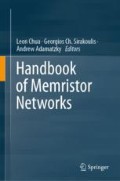Abstract
Memristor is a new circuit element defined by a state-dependent Ohm’s law between the memristor voltage and current. It has recently been successfully built, however, its electrical characteristics are not fully known yet. Like other circuit elements R, L and C, there could have various configurations of multiple memristors including serial and parallel connections in a variety of applications. When input voltage/current is supplied to a circuit with multiple memristors, behavior of the device becomes complicated and is difficult to predict. In this chapter, composite characteristics of the serial and parallel connections of memristors are investigated using both linear and nonlinear models. Also, the behavior of individual memristor is formulated mathematically and a general computation method of composite memristance for multiple memristor circuits of diverse configurations is proposed.
Access this chapter
Tax calculation will be finalised at checkout
Purchases are for personal use only
References
Chua, L.O.: Memristor-the missing circuit element. IEEE Trans. Circ. Theor. CT–18(5), 507–519 (1971)
Chua, L.O., Kang, S.M.: Memristive devices and systems. Proc. IEEE 64(2), 209–223 (1976)
Kim, H., Adhikari, S.P.: Memistor is not memristor. IEEE Circ. Syst. Mag. 12(1), 75–78 (2012)
Wang, F.Y.: Memristor for introductory physics. arXIv: 0808.0286v1 [physics,Class-ph] (2008)
Strukov, D.B., Snider, G.S., Stewart, D.R., Williams, R.S.: The missing memristor found. Nature 453(7191), 80–83 (2008)
Kavehei, O., Eqbal, A., Kim, Y.S., Eshraghian, K., Al-sarawi, S.F., Abbott, D.: The fourth element: characteristics, modelling and electromagnic theory of the memristor. Proc. R. Soc. A Math. Phys. Eng. Sci. 466(2120), 2175–2202 (2010)
Rak, A., Cserey, G.: Macro modelling of memristors in SPICE. IEEE Trans. Comput. Aided Des. Integr. Circ. Syst. 29(4), 632–636 (2010)
Biolek, Z., Biolek, D., Biolková, V.: SPICE model of memristor with nonlinear dopant drift. Radio Eng. 18(2), 210–214 (2009)
Benderli, S., Wey, T.A.: On SPICE macromodelling of \(TiO_{2}\) memristors. Electron. Lett. 45(7), 377–379 (2009)
Kim, H., Sah, M.P., Yang, C., Cho, S., Chua, L.O.: Memristor emulator for memristor circuit applications. IEEE Trans. Circuits Syst. I 59(10), 2422–2431 (2012)
Pershin, Y.V., Ventra, M.D.: Practical approach to programmable analog circuits with memristors. IEEE Trans. Circ. Syst. I Regul. Pap. 57(8), 1857–1864 (2010)
Multu, R., Karakulak, E.: Emulator circuit of \(TiO_{2}\) memristor with linear dopant drift made using analog multiplier. In: 2010 National Conference on Electrical, Electronics and Computer Engineering (ELECO), pp. 380–384 (2010)
Joglekar, Y., Wolf, S.: The elusive memristor: properties of basic electrical circuits. Eur. J. Phys. 30, 661–675 (2009)
Kim, H., Sah, M.P., Yang, C., Roska, T., Chua, L.O.: Neural synaptic weighting with a pulse-based memristor circuit. IEEE Trans. Circuits Syst. I 59(1), 148–158 (2012)
Kim, H., Sah, M.P., Yang, C., Roska, T., Chua, L.O.: Memristor bridge synapses. Proc. of the IEEE 100, 2061–2070 (2012)
Sah, M.P., Yang, C., Kim, H., Chua, L.: A voltage mode memristor bridge synaptic circuit with memristor emulators. Sensors 12(3), 3587–3604 (2012)
Linn, E., Rosezin, R., Kügeler, C., Waser, R.: Complementary resistive switches for passive nanocrossbar memories. Nat. Mater. 9(5), 403–406 (2010)
Kavehei, O., Al-Sarawi, S., Cho, K., Eshraghian, K., Abbott, D.: An analytical approach for memristive nanoarchitectures. IEEE Trans. Nanotech. 11(2), 374–385 (2012)
Liu, T., Kang, Y., Verma, M., Orlowski, K.: Switching characteristics of antiparallel resistive switches. IEEE Electron Device Lett. 33(3), 429–431 (2012)
Niu, D., Chen, Y., Xu, C., Xie, Y.: Impact of process variations on emerging memristor. In: 47th ACM/IEEE Design Automation Conference (DAC), pp. 877–882 (2010)
Author information
Authors and Affiliations
Corresponding author
Editor information
Editors and Affiliations
Rights and permissions
Copyright information
© 2019 Springer Nature Switzerland AG
About this chapter
Cite this chapter
Budhathoki, R.K., Pd. Sah, M., Prasad Adhikari, S., Kim, H., Chua, L. (2019). Behavior of Multiple Memristor Circuits. In: Chua, L., Sirakoulis, G., Adamatzky, A. (eds) Handbook of Memristor Networks. Springer, Cham. https://doi.org/10.1007/978-3-319-76375-0_31
Download citation
DOI: https://doi.org/10.1007/978-3-319-76375-0_31
Published:
Publisher Name: Springer, Cham
Print ISBN: 978-3-319-76374-3
Online ISBN: 978-3-319-76375-0
eBook Packages: Computer ScienceComputer Science (R0)

